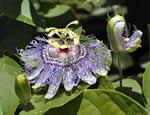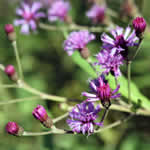 |
Great Native Plant Alternatives
Kick the Invasive Exotic Gardening Habit with Great Native Plant Alternatives
It’s time to eradicate those unruly invasives from your garden and add some new choices to your plant inventory. Famous for stepping beyond garden boundaries, invasive exotics wreak havoc on natural areas. We have all seen how English ivy smothers wildflowers and topples shade trees or how Japanese honeysuckle literally strangles shrubs and small trees. Leaving old garden standards behind is difficult but necessary if our natural parks, forests, and fields are to have a future.
Invasive plants turn into landscape thugs by out-competing the surrounding natives. In the mid-Atlantic region, they tend to put their leaves out earlier in the spring and lose them later in the fall than their native counterparts. This extended growth period gives them a significant advantage over the native species. In addition, these plants have no natural enemy—neither insect nor disease—and quickly produce abundant offspring. Many invasive plants are unpalatable to deer and quickly take over where deer are abundant.

Purple passionflower
(Passiflora incarnata).
Before choosing a native plant alternative, first think about the characteristics of the invasive plant you are replacing. Using Japanese honeysuckle as an example, its sweet fragrance or vining habit might be the desired characteristics. So, get rid of the honeysuckle and replant with fragrant summer bloomers like sweetbay magnolia, Magnolia virginiana, a tree, and add the summer-blooming leatherflower vine, Clematis viorna, if you like the vine habit. The new combination gives you everything you liked about the honeysuckle without its devastating weediness.
Native Plant Alternatives\1
| Problem Plant |
Desirable Characteristics |
Great Alternatives |
| Japanese Wisteria |
showy flowers, fragrance |
woodland phlox, Phlox divaricatus
sweet azalea, Rhododendron canescens
coast azalea, Rhododendron atlanticum
American wisteria, Wisteria frutescens |
| Japanese Honeysuckle |
fragrant flowers |
leatherflower, Clematis viorna
Carolina jasmine, Gelsemium sempervirens
trumpet honeysuckle, Lonicera sempervirens
sweetbay magnolia, Magnolia virginiana
purple passionflower, Passiflora incarnata |
| English Ivy |
Drought Tolerant Evergreen |
plantain-leaved sedge, Carex plantaginea
marginal woodfern, Dryopteris marginalis
woodland aster, Eurybia divaricatus
alumroot, Heuchera villosa
creeping mint, Meehania cordata
Allegheny spurge, Pachysandra procumbens
creeping phlox, Phlox stolonifera
Solomon’s seal, Polygonatum biflorum
Christmas fern, Polystichum acrostichoides |
| Autumn Olive |
Drought Tolerant |
strawberry bush, Euonymus americanus
wax-myrtle, Myrica cerifera
meadowsweet, Spiraea latifolia
mapleleaf viburnum, Viburnum acerifolium |
| Barberry |
Cheap/Nice Fruit |
strawberry bush, Euonymus americanus
shrubby St. Johnswort, Hypericum prolificum
winterberry, Ilex verticillata
deerberry, Vaccinium stamineum
mapleleaf viburnum, Viburnum acerifolium |
| Purple Loosestrife |
Long Bloom Season/Wet Tolerant |
swamp milkweed, Asclepias incarnata
sweet pepperbush, Clethra alnifolia
purple coneflower, Echinacea purpurea
gayfeather, Liatris spicata
grass-leaved blazing star, Liatris pilosa
green-headed coneflower, Rudbeckia laciniata
New York ironweed, Vernonia novaboracensis |
| Miscanthus species |
Strong Vertical and Fall/Winter Interest |
split-beard bluestem, Andropogon ternarius
switchgrass, Panicum virgatum
sugarcane plumegrass, Saccharum giganteum
little bluestem, Schizachyrium scoparium
Indiangrass, Sorghastrum nutans |
| Lesser Celandine |
Early Color |
spring beauty, Claytonia virginica
yellow ragwort, Senecio aureus
Other spring ephemerals, if nursery propagated |
| Asian Bittersweet |
Showy Fruits |
American bittersweet, Celastrus scandens
Virginia rose, Rosa virginiana |
| Porcelainberry |
Fast Grower/Colorful Fruits |
gray dogwood, Cornus racemosa
Virginia creeper, Parthenocissus quinquefolia
swamp haw viburnum, Viburnum nudum |
| Shrubby honeysuckle |
Replant after removal |
spicebush, Lindera benzoin
highbush blueberry, Vaccinium corymbosum
arrow-wood viburnum, Viburnum dentatum |
| Burning Bush Euonymus |
Fall Color |
fringed bluestar, Amsonia ciliata
Hubricht’s bluestar, Amsonia hubrichtii
witch-alder, Fothergilla gardenii
oak-leaf hydrangea, Hydrangea quercifolia
fetterbush, Leucothoe racemosa
swamp haw, Viburnum dentatum
arrow-wood viburnum, Viburnum nudum |
Note: This list is based upon invasive plants in the mid-Atlantic region. For more information on invasive plants in your region, please check out the following web sites:
|


